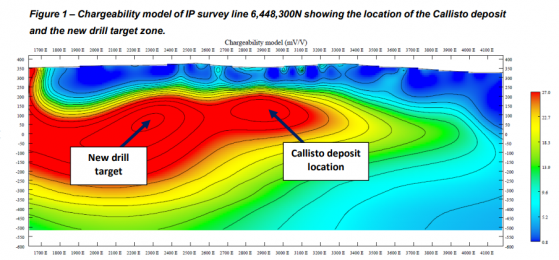Galileo Mining Ltd (ASX:GAL, OTC:GLMGF) has fielded encouraging results from geophysical IP surveying at the Callisto deposit within the company’s 100%-owned Norseman project in Western Australia.
The results indicate that there are strong chargeable features associated with the Callisto deposit and geological modelling has confirmed a lower ultramafic sill target zone beneath the deposit that matches the geophysical target.
On the scent of platinum, palladium and gold
The North Callisto prospective sulphide trend is along strike from a drill hole that yielded 28 metres at 0.18 g/t platinum, palladium and gold (3E) when the company drilled it in September.
It has been interpreted as geologically analogous to Callisto, where the host intrusive sill overlies a volcano-sedimentary sequence.
Galileo is confident that the results highlight the significant prospectivity of the overall ultramafic-mafic sill complex, which appears to have developed as multiple intrusive events over the full 20-kilometre strike length.
Accordingly, the zone along strike of the hole will be targeted in the upcoming drill campaign and the prospect area is subject to ongoing IP surveying aimed at identifying sulphide mineralisation.
The next round of drilling is scheduled to commence in early December and will test the Callisto and North Callisto prospects.
Results from Jimberlana
The Jimberlana Prospect is an east-west trending ultramafic-mafic dyke with sulphides developed on the northern and southern margins.
Drilling by Galileo has intersected wide zones of anomalous PGE-nickel-copper sulphide at the Jimberlana South prospect at the juncture between mafic and ultramafic rock units in contact with the host country rock.
Drilling of the Jimberlana South prospect will be included in the December drill program to follow up near surface results including:
- 28 metres at 0.34 g/t 3E, 0.20% copper, and 0.14% nickel from 32 metres within fresh rock sulphide zone; and
- 8 metres at 0.50 g/t 3E, 0.29% copper, and 0.19% nickel from 40 metres.
Results from reverse circulation (RC) drilling in October show more anomalous palladium-platinum results including:
- 28 metres at 0.36 g/t 3E3 from surface;
- 96 metres at 0.18 g/t 3E from surface;
- 80 metres at 0.12 g/t 3E from 64 metres;
- 28 metres at 0.17 g/t 3E from 100 metres; and
- 16 metres at 0.22 g/t 3E from 252 metres.
The company is continuing to conduct geophysical IP surveying at the North and South Callisto prospects, with results due next month.
2024 program
Next year, IP surveying will cover the 20-kilometre prospective strike length around Callisto and generate further targets for drill testing the North Callisto Prospect following a first pass in September and the second round of drilling completed in October.
Drilling at South Callisto also confirmed highly anomalous PGEs in a fertile ultramafic rock sequence and geophysical IP surveying planned for 2024 has been designed to cover four lines at the South Callisto prospect to develop sulphide targets for drill testing.
Read more on Proactive Investors AU
